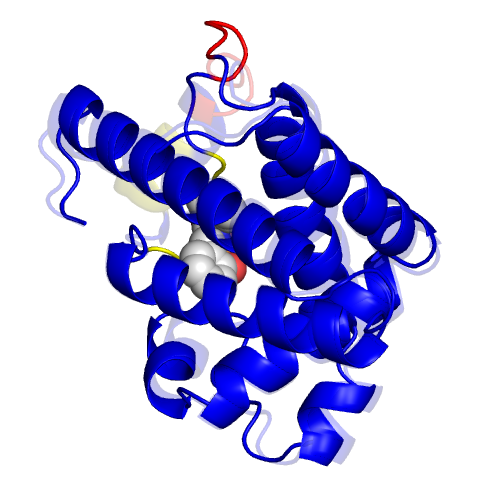CL.39 |
MYOGLOBIN |
|
|
|
Ligand |
PDB*1 |
Full name |
CUP |
(N-SALICYLIDEN-L-PHENYLALANATO)-COPPER(II) |
|
*1 Ligand name designated by the PDB identifiers. |
Segments |
Component No. |
Fixed*1 |
Moving*1 |
Motion type |
Ligand binding |
Coupled motion type |
1 |
D1(0A-81A,87A-89A,97A-153A) |
L2(90A-96A) |
Local |
Coupled |
Opening |
2 |
D1 |
L3(82A-86A) |
Local |
Independent |
|
*1 The location of the fixed and moving segments indicated by the residue number assigned in the ligand-bound form. The background color of characters indicates the corresponding segment in the structure. The colored segments not described in the Table are: 1) a part of component in which the motion is small (< 1.0 A), or, 2) a part of a protomer of homodimers, for which a corresponding part of the other protomer is shown in the Table. |
Displacement and disorder |
Component No. |
RMSD*1 |
Displacement*2 |
Disorder-order transition*3 |
Disorder residue*4 |
Helix-Coil*5 |
1 |
8 |
-6 |
|||
2 |
4.3 |
+3 |
|
*1 The root-mean-square displacement of a component of motion calculated for the domain motions. |
Linear response |
Component No. |
Correlation coefficient*1 |
1 |
0.68 |
2 |
|
*1 The correlation coefficient between the displacement vector predicted by the linear response theory and the one observed in the crystal structures. |
Crystal environment |
Component No. |
Open state*1 |
Crystal packing*2 |
1 |
||
2 |
Bound |
Coupled |
|
*1 Distinction between the open state and the closed state required for examining the influence of the crystal environment. |

